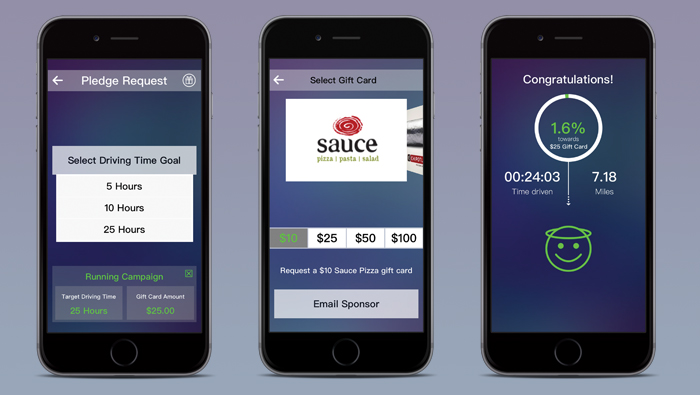David Hazan is a man on a mission. His goal: to save lives on the road by getting drivers to change one habit – put down our cell phones. Period.
And the 34-year-old entrepreneur has created a mobile app that succeeds in doing just that, one distracted driver at a time.
According to a 2013 study by the Center for Disease Control and Prevention, each day in the United States, more than 8 people are killed and 1,161 injured in crashes involving a distracted driver. This study also noted that motor vehicle crashes are the leading cause of death for teens.
“Annually, 2,900 teenage deaths and 200,000 plus hospitalizations are inexcusable for something that we really can just put down,” says David, who moved back to his hometown of Tucson in 2013.
Although texting is certainly not the only distraction while driving, it has the potential to be much more deadly, according to the CDC. Texting takes the driver’s attention away from driving more frequently and longer than other distractions. At 55 mph, the average text takes your eyes off the road long enough to cover the length of a football field.
In 2014, David, who grew up in Tucson and graduated from the University of Arizona with a triple major in finance, economics and entrepreneurship, began working with a software developer to address the distracted driving epidemic. They took the idea to the Code for Tucson 2014 Civic Hackathon, where they won an award for Best Commercial Potential.
The result is Down for the Count, an app that rewards users for ignoring their cell phones while in a moving vehicle. After downloading the app, the user sets up a campaign to abstain from cell phone use for a certain number of driving hours and selects the reward incentive. For example, a $5 gift card for five hours of phone-free driving, $10 for 10 hours, or $25 for 25 hours. Gift card selections include local restaurants, iTunes and online retailers. The user also chooses a sponsor (typically a parent) to approve the campaign and agree to pay for the reward. Once the campaign is approved, the user just taps “Start” when they get in the car and “Stop” when they reach their destination. The app runs in the background and keeps track of the time. It allows the use of maps and music apps, as long as the user starts them before turning on DFTC and doesn’t touch them while the app is running. When the user completes a campaign, the reward is automatically downloaded to their smartphone and ready to use.
The idea behind the app is to provide an incentive that gets us to break our habit of incessant smartphone use. Sounds powerful, but does it work?
David has anecdotal evidence from students in a Tucson-based pilot program who say that yes, it does. “I get thank you emails from teens, themselves. When I speak to school assemblies I hear, ‘I used to use my phone all the time, but now I think about it. Even if I forget to run your app, I still think not to use my phone.’ And that is really what keeps me going,” David says. Once the habit is established, some teens even reduce the 25-hour reward from $25 to $10. It becomes about being safe and responsible, not just getting free food or music.
That’s really saying something, when you consider that the average teen spends between 12 to 18 hours a day on their phone. In the first eight months of the pilot program, which was launched in August 2015, users drove more than 150,000 cellphone-free miles.
David’s business model for the future is to partner with insurance companies to offer discounts for users who achieve certain metrics or who use DFTC on a regular basis. That’s when he hopes he’ll begin to see a return on his investment.
He acknowledges that teens are not the only ones who suffer from distracted driving. He admits that it took him about a year to break his own smartphone addiction. “I didn’t think I had an addiction before I created the app,” David says, “But you get to that red light and you know you have a minute, so, of course, you’re going to engage with your cellular device, because it’s so quick and easy. The problem is, that’s your gateway drug. You’re rarely finished with your conversation, and that’s where the risk can occur.
“The toughest part about this fight is that most of us have done it tens, hundreds, thousands of times and never been in an accident, never killed somebody. Maybe you’ve had a close call or two, but the sad thing is you get this reinforcement cycle of checking your phone at a light and nothing ever happens. And the awful thing with distracted driving accidents is that they’re random. You become inattentive and boom, the accident occurs.”
Smartphone distractions don’t stop with the driver. “You can have a good, safe driver, but the passenger next to him gets this hilarious Snapchat video and, of course, the driver looks over at the video because it’s going to disappear forever,” says David. That’s why he’s partnering with high schools to get teens from all grades involved, even if they’re not driving yet. (And he’s looking for additional schools, sports teams, youth groups and other organizations who want to help spread the word and increased usage… hint, hint.)
With the prevalence of these temptations, is society capable of enacting the change needed to make a difference? David thinks so. “We’ve done it before. In 1984, seatbelt usage in the United States was 9% and now it’s 90%. It took 30 years to increase use of the number one thing that prevents death from accidents. We don’t need to have 30 years of losing 2,900 teens a year. The only way to stop this is to put our phones down.”
You can download the free Down for the Count iPhone app from the App Store and it will soon be available for Android phones, too. For more information, visit downforthecountapp.com or email David at david@putitdownapp.com.






